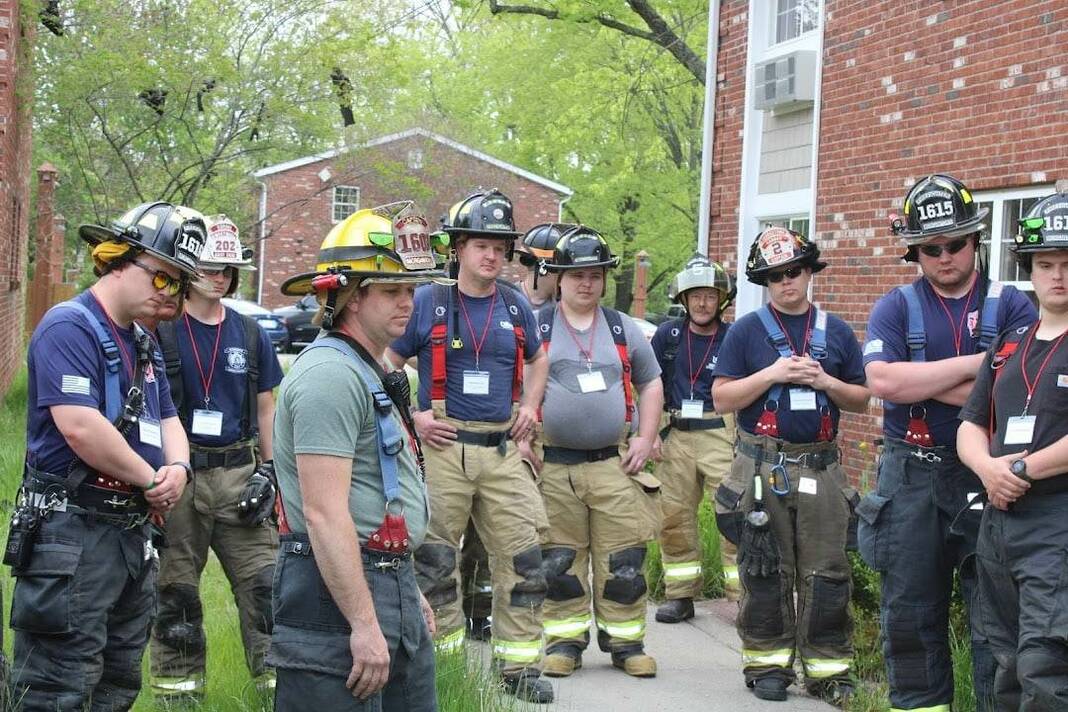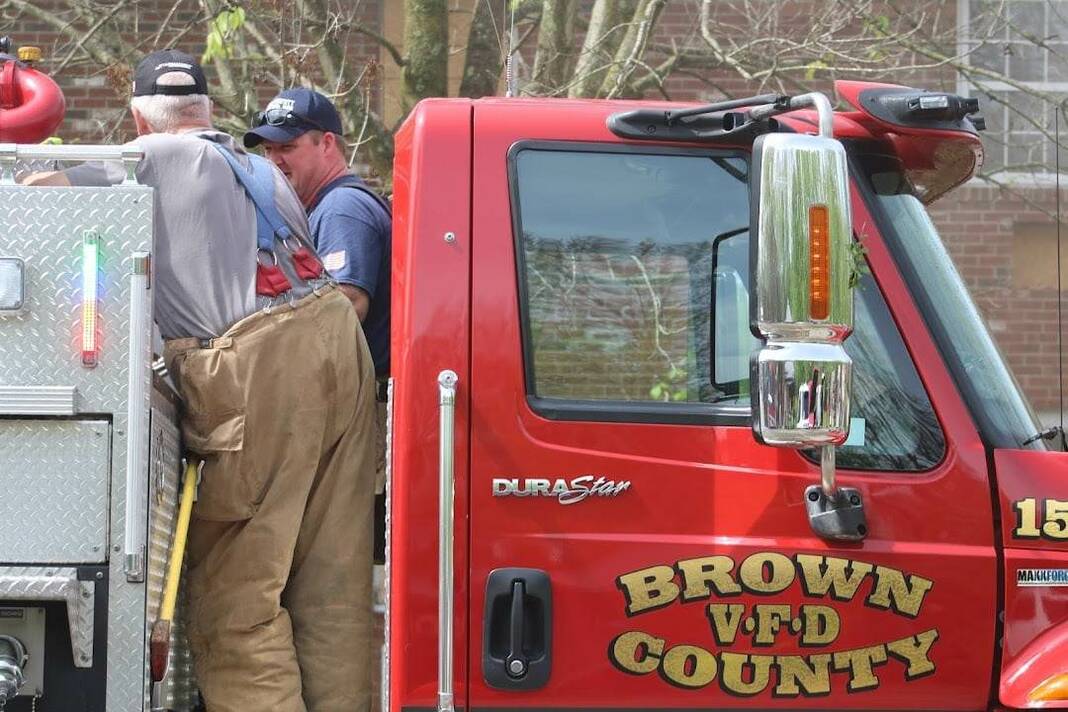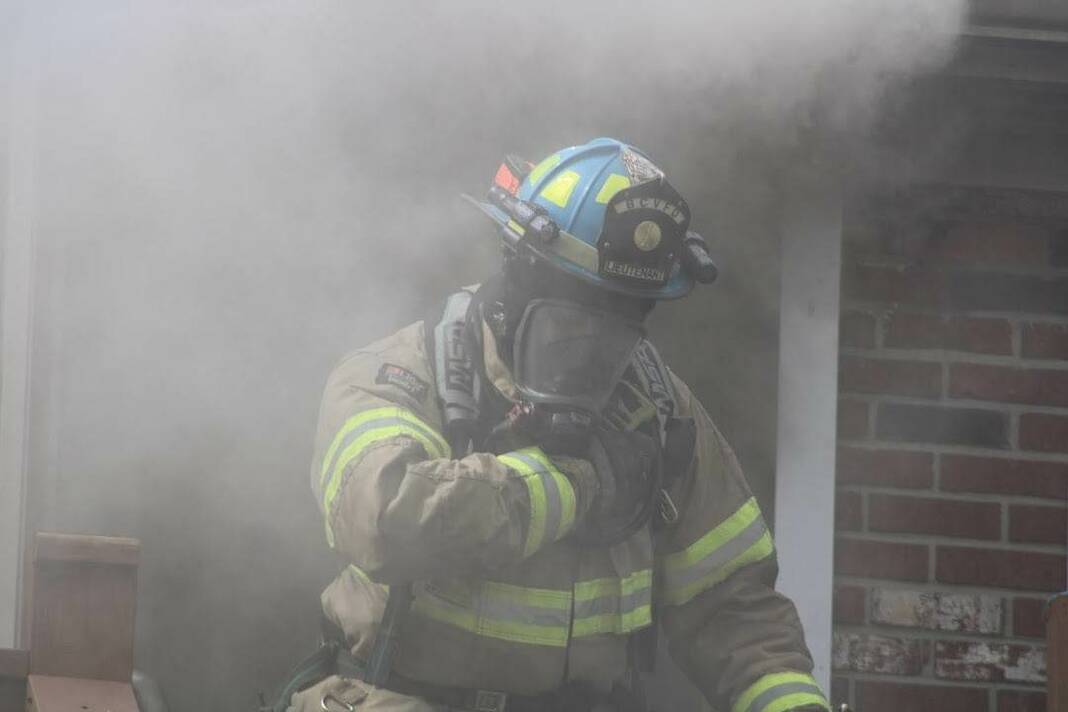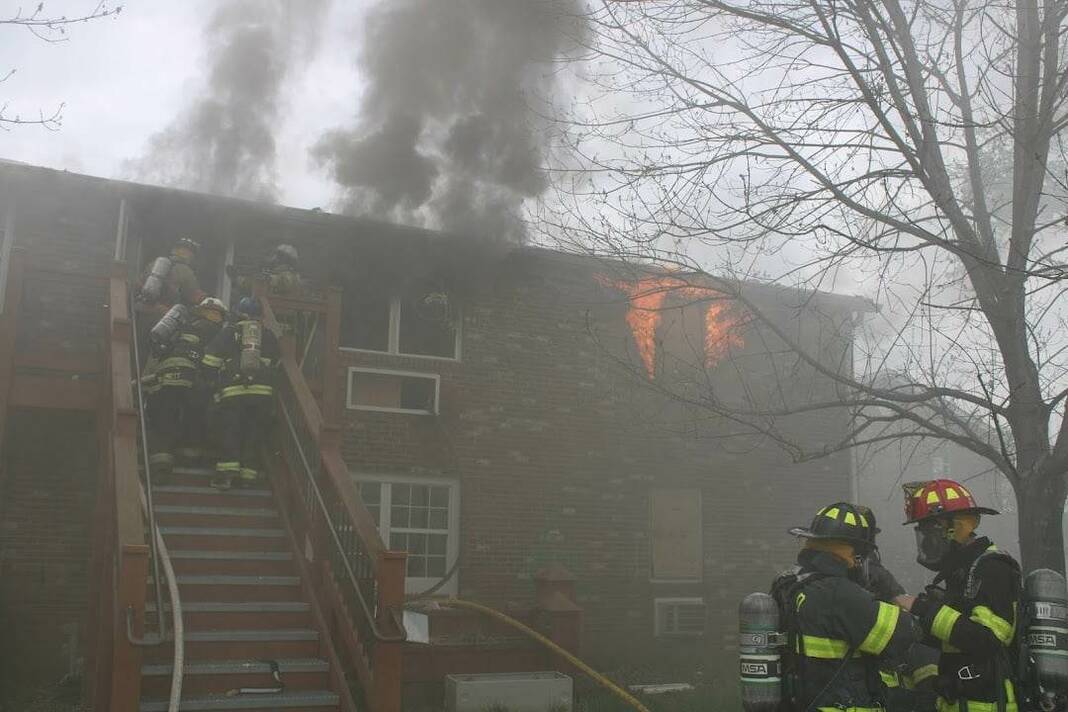
Firefighters from ten departments across the state participated in live fire training hosted by Brown County Volunteer Fire Department on May 6 and 7.
Submitted photo

Brown County Volunteer Fire Department firefighter Adam Shelton (right) learns how to operate and pump a fire engine from fellow firefighter/instructor Dak Kelp (left).
Submitted photo

Brown County Volunteer Fire Department 1st Lt. Hunter Riebl is seen entering the building for a search and rescue drill with live fire in the building.
Submitted photo

Brown County Volunteer Fire Department 1st Lt. Hunter Riebl is seen exiting the building after doing a search and rescue drill with live fire in the building.
Submitted photo

Fire crews are seen entering the building for fire attack in an apartment on the second floor of the building.
Submitted photo
Local firefighters had the rare opportunity to be hosts for a live fire training earlier this month just off State Road 46 toward Columbus. Former owners Creekside Retreat donated the property with 10 buildings on 47 acres to the Brown County Volunteer Fire Department to use as they see fit.
On May 6 and 7, firefighters from the BCVFD and several other surrounding departments gathered on the property to run through a variety of live training scenarios. Firefighters set controlled fires in one of the apartment-style buildings on the property, which created real smoke and heat to as closely simulate real fire emergencies as possible.
BCVFD Chief Shawn Fosnight said last week that 10 different departments from across the state showed up for the training weekend. There were around 15 instructors there as well, and a few of them traveled from far away, including up north — like Gary — and even out of state — Pennsylvania and Ohio — to help instruct local firefighters.
Because the Brown County area does not have many apartment buildings, Fosnight said having instructors come from more metropolitan areas, where apartment-style structure fires are more their “specialty,” really benefitted the overall learning experience.
“Having that kind of experience is fabulous,” Fosnight said.
According to Fosnight, fire departments do not get opportunities like this very often, if at all.
Most typically, he said, fire departments get to use single-family dwellings for live training purposes — for instance, sometimes families purchase property and wish to remove an existing structure on that property, so they donate it to fire departments to burn down.
Getting the chance to use multiple, full-sized, multiple-dwelling apartment buildings for live training is a more rare opportunity.
“Several of the people were calling it a ‘once-in-a-career opportunity,’” Fosnight said.
NFD only used one building on the property. Fosnight said there are eight apartment units in that building, and they utilized each one. The different apartments allowed the firefighters to set up and carry out multiple different training scenarios.
Attendees spent all day on the property, from around 8:30 a.m. to 5 p.m. both days, according to Fosnight. There were 50 available slots for students to sign up and register, and with the addition of the instructors and state-level officials, there were a total of around 70 people in attendance.
“There were several opportunities for skills to be learned both of those days,” Fosnight said.
The main focus of the training was on live burn scenarios, and woven into those scenarios was training for search and rescue, forcible entry, operation of firetruck pumps and more.
In addition, because of the way the building is designed — with stairs to the upper level on both sides and a landing across the top floor that connected the staircases — firefighters were able to simulate a below-grade fire, or a fire in a basement or lower-level of a building.
Each floor had four apartments, Fosnight said. For search and rescue training, they set a fire in one apartment and placed a rescue dummy in another.
“While one crew was going in and extinguishing the fire, we had a second crew go in for search and rescue training,” he said.
Fosnight said the firefighters went in with real smoke, searching the building for victims, just like they would if they were responding to a structure fire.
“Being able to do it with live smoke and actual conditions, it was great,” Fosnight said.
“Everybody thought it went great. It ran very smoothly. We had a lot of positive feedback and everybody said they wanted us to do it again.”
Fosnight said they hope to do an event like this again in the near future, using more of the buildings on the property. The plan is, according to him, that every building there will come down at some point, but there is a planning process involved in each training event.
The planning required BCVFD members to contact state organizations for clearance, such as the Indiana Department of Emergency Management. Special precautions have to be taken to ensure everything on site burns cleanly, limiting the amount of toxic materials and fumes for both the firefighters on scene and the surrounding environment.
That means that BCVFD members, over the course of the past several months, went to the property and stripped it of nearly everything except natural materials. Fosnight said they removed carpet and the padding under the carpet, as well as plastics, piping and wiring in the walls, floors and ceiling.
The windows, shingles and tar paper under the shingles also had to be removed, but Fosnight said they waited to do those last, to reduce the chance of rain saturating the property and affecting how it burned.
To light the fires, Fosnight said they used some hay, surrounded by three wood pallets. Those materials are natural and closely resemble smoke and flames in any real emergency situation.
Fosnight wished to highlight hard work done for this opportunity by Hunter Riebl, a member of the BCVFD. According to Fosnight, Riebl’s work over the past six to eight months made the live training possible.
Fosnight wanted to give a big thanks to those who shared their expertise and reources, including Eric Green and Thomas Nienaber from Diesel Town F.O.O.L.S., Chris Reichel from Key Hose, T.R. Hagerty and John Shafer from the Indiana Department of Homeland Security, Rob Grady from the Gary, Indiana Fire Department, and many other instructors and volunteers.
He also said he is very appreciative of the public and their support, especially how everyone was respectful of it being a closed training. Having it closed to the public allowed them to fully focus and get the most out of their training.

